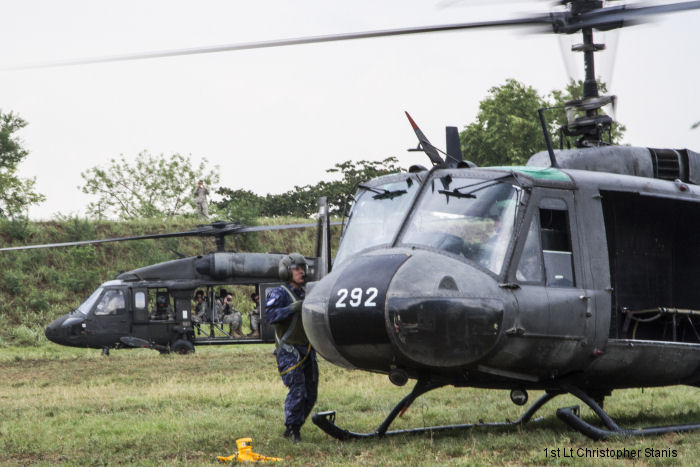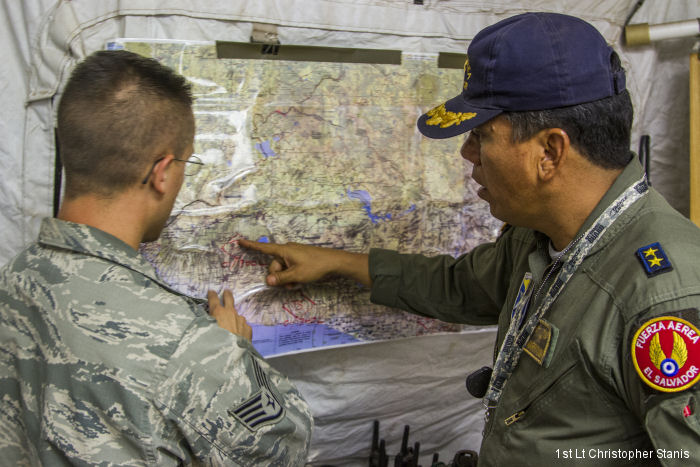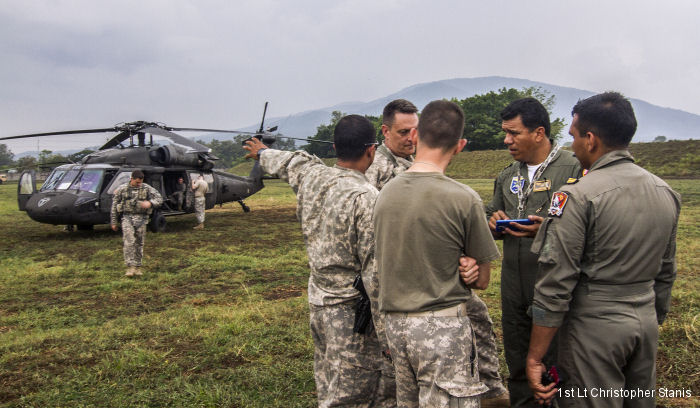US Army, May 08, 2015 - SAN SALVADOR, El Salvador by 1st Lt Christopher Stanis – U.S. and Salvadoran helicopter pilots have partnered to enhance their casualty evacuation capabilities during the U.S. Army-led humanitarian exercise Beyond the Horizon 2015.
Task Force Northstar, the exercise’s U.S. contingent in El Salvador, is responsible for all CASEVAC operations during the day when U.S., host nation, and other partner nation soldiers are working at the various humanitarian project sites throughout El Salvador. But at night everyone returns to their base of operations at the Comando de Ingenieros de la Fuerza Armada, the Salvadoran equivalent of the U.S. Army Engineer Command.
Only a small element of Salvadoran security forces are left to guard the worksites after sunset and U.S. aviators do not have radio communication with them.
“There was a little bit of a gap,” said Maj. Jose Reyes, commander of Charlie Company, 2-149th General Support Aviation Battalion. “Because we don’t have that communication with those security, there was a little bit more of a risk, a very high risk to go on a CASEVAC at night. And that’s where the Salvadoran helicopter would prepare and conduct CASEVAC on their soldiers who are at the sites.”
Reyes said the original plan for partnership with the Salvadoran air force was to just work with a liaison officer. Then, about a month into their tour here, the idea was discussed for bringing in a Salvadoran helicopter and mentoring crews on CASEVAC operations to ensure 24-hour support was available to the worksites.
“We wanted to open that envelope of instead of just being here and working with the task force, but simultaneously working with the Salvadorans and exchanging best practices, and continuing the partnership to another level,” said Reyes. “U.S. Army South and SOUTHCOM [U.S. Southern Command] accepted this mission and our proposal, and we were able to allocate funds, certain funds, in order to support this mission.”
Now having Salvadoran helicopter crews co-located at CIFA, Task Force Northstar aviators designed an interchange to developing and enhancing each other’s capabilities.
“As Salvadorans we have procedures we might use, but they’re different from the United States, so we are learning and will be able to apply things to the way we do it,” said Salvadoran air force Lt. Col. Hector Marroquin, a Huey helicopter pilot attached to the Beyond the Horizon CASEVAC mission. “This is helping us, so in the future we can provide better casualty extraction to a mission.”
The Salvadoran air force developed a rotation plan of two new helicopter crews to the mission every 15 days in order to get flight time for as many pilots as possible.
This is the first opportunity to work with American forces for Capt. Rene Sermano, a nine-year veteran helicopter pilot with the Salvadoran air force. He said they do not get to fly much because of funding, so this partnership is a great chance for training in addition to providing real-world casualty evacuation support.
“Usually we have practice different months in the year, but sometimes we have limitations with fuel, so sometimes we practice in a real emergency,” said Sermano.
He noted, however, that El Salvador’s dangerous situation with violence necessitates them to be ready to deliver CASEVAC operations anytime, anywhere. So it is important to have the training before the emergency.
The Americans and Salvadorans are not flying missions together, but they have coordinated efforts to ensure operations are consistent. This has included classes on CASEVAC procedures, observations of rehearsals and developing standard operating procedures for initiating a mission.
“I’m not worried about their flying, they’re experienced in that aspect,” said Reyes. “We want to know they have the procedures down for this [CASEVAC mission].”
Another key part of assuming the mission was for the Salvadorans to familiarize themselves with the area. It is their country, but they needed to know, from a bird’s eye view, the locations and layouts of all the worksites. The helicopter crews conducted daytime and nighttime training flights for this.
“We need to know specifically where we can land,” said Sermano, illustrating the importance of such flights. “If we don’t have a safety area, we can’t land, so we need to make a recognition.”
Since its conception, the U.S.-Salvadoran aviation partnership has evolved beyond the CASEVAC mission.
“We came over here with the understanding that we were going to conduct CASEVAC, and conduct any other missions, but we were internally interested in their [Salvadoran] … aviation operations,” said Reyes. “With that we’re also building our experiences and getting to know our partner nation … so it’s a great experience and an eye-opening experience to see what they work with.”
Task Force Northstar, the exercise’s U.S. contingent in El Salvador, is responsible for all CASEVAC operations during the day when U.S., host nation, and other partner nation soldiers are working at the various humanitarian project sites throughout El Salvador. But at night everyone returns to their base of operations at the Comando de Ingenieros de la Fuerza Armada, the Salvadoran equivalent of the U.S. Army Engineer Command.
Only a small element of Salvadoran security forces are left to guard the worksites after sunset and U.S. aviators do not have radio communication with them.
“There was a little bit of a gap,” said Maj. Jose Reyes, commander of Charlie Company, 2-149th General Support Aviation Battalion. “Because we don’t have that communication with those security, there was a little bit more of a risk, a very high risk to go on a CASEVAC at night. And that’s where the Salvadoran helicopter would prepare and conduct CASEVAC on their soldiers who are at the sites.”
Reyes said the original plan for partnership with the Salvadoran air force was to just work with a liaison officer. Then, about a month into their tour here, the idea was discussed for bringing in a Salvadoran helicopter and mentoring crews on CASEVAC operations to ensure 24-hour support was available to the worksites.
“We wanted to open that envelope of instead of just being here and working with the task force, but simultaneously working with the Salvadorans and exchanging best practices, and continuing the partnership to another level,” said Reyes. “U.S. Army South and SOUTHCOM [U.S. Southern Command] accepted this mission and our proposal, and we were able to allocate funds, certain funds, in order to support this mission.”
Now having Salvadoran helicopter crews co-located at CIFA, Task Force Northstar aviators designed an interchange to developing and enhancing each other’s capabilities.
“As Salvadorans we have procedures we might use, but they’re different from the United States, so we are learning and will be able to apply things to the way we do it,” said Salvadoran air force Lt. Col. Hector Marroquin, a Huey helicopter pilot attached to the Beyond the Horizon CASEVAC mission. “This is helping us, so in the future we can provide better casualty extraction to a mission.”
The Salvadoran air force developed a rotation plan of two new helicopter crews to the mission every 15 days in order to get flight time for as many pilots as possible.
This is the first opportunity to work with American forces for Capt. Rene Sermano, a nine-year veteran helicopter pilot with the Salvadoran air force. He said they do not get to fly much because of funding, so this partnership is a great chance for training in addition to providing real-world casualty evacuation support.
“Usually we have practice different months in the year, but sometimes we have limitations with fuel, so sometimes we practice in a real emergency,” said Sermano.
He noted, however, that El Salvador’s dangerous situation with violence necessitates them to be ready to deliver CASEVAC operations anytime, anywhere. So it is important to have the training before the emergency.
The Americans and Salvadorans are not flying missions together, but they have coordinated efforts to ensure operations are consistent. This has included classes on CASEVAC procedures, observations of rehearsals and developing standard operating procedures for initiating a mission.
“I’m not worried about their flying, they’re experienced in that aspect,” said Reyes. “We want to know they have the procedures down for this [CASEVAC mission].”
Another key part of assuming the mission was for the Salvadorans to familiarize themselves with the area. It is their country, but they needed to know, from a bird’s eye view, the locations and layouts of all the worksites. The helicopter crews conducted daytime and nighttime training flights for this.
“We need to know specifically where we can land,” said Sermano, illustrating the importance of such flights. “If we don’t have a safety area, we can’t land, so we need to make a recognition.”
Since its conception, the U.S.-Salvadoran aviation partnership has evolved beyond the CASEVAC mission.
“We came over here with the understanding that we were going to conduct CASEVAC, and conduct any other missions, but we were internally interested in their [Salvadoran] … aviation operations,” said Reyes. “With that we’re also building our experiences and getting to know our partner nation … so it’s a great experience and an eye-opening experience to see what they work with.”
UH-1H Iroquois 292 ( Fuerza Aerea Salvadoreña )
See also |
1-228 AVN
205 in







